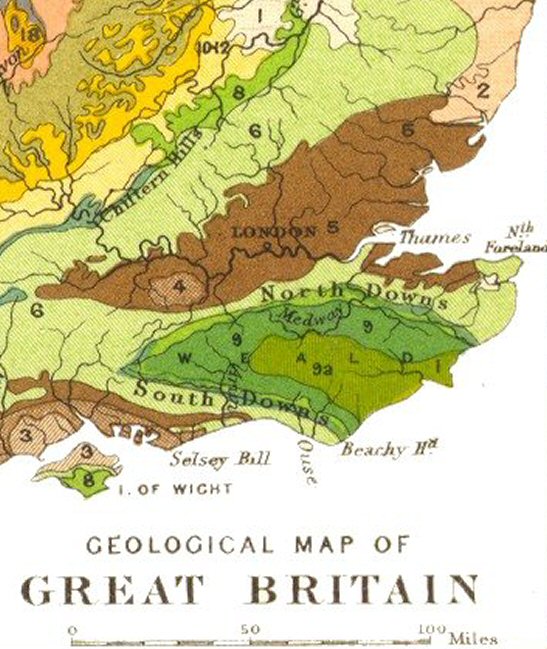|
Kingston, Kent
Kingston is a village and civil parish between Canterbury and Dover in Kent, South East England. The parish contains the hamlet of Marley. History The Kingston Brooch, an important piece of Anglo-Saxon jewellery dating from the 7th Century, was discovered in a tumulus on Kingston Downs in 1771 by the Reverend Bryan Faussett (1720–1776), then Rector of Kingston. It is 8 cm in diameter, made of gold, with garnet, blue glass and shell settings. It is now on display in the World Museum in Liverpool. Geography The village is centred 5 miles south east of the city centre of Canterbury on the edge of the North Downs in rolling hilly countryside that is an Area of Outstanding Natural Beauty. Religious sites The local church, dedicated to Saint Giles, originated during the 11th century, and is now part of the Barham Downs group of churches. The walls of the nave and about two-thirds of the present chancel are thought to be original, the chancel being extended in the 13th cen ... [...More Info...] [...Related Items...] OR: [Wikipedia] [Google] [Baidu] |
United Kingdom Census 2011
A Census in the United Kingdom, census of the population of the United Kingdom is taken every ten years. The 2011 census was held in all countries of the UK on 27 March 2011. It was the first UK census which could be completed online via the Internet. The Office for National Statistics (ONS) is responsible for the census in England and Wales, the General Register Office for Scotland (GROS) is responsible for the census in Scotland, and the Northern Ireland Statistics and Research Agency (NISRA) is responsible for the census in Northern Ireland. The Office for National Statistics is the executive office of the UK Statistics Authority, a non-ministerial department formed in 2008 and which reports directly to Parliament. ONS is the UK Government's single largest statistical producer of independent statistics on the UK's economy and society, used to assist the planning and allocation of resources, policy-making and decision-making. ONS designs, manages and runs the census in England an ... [...More Info...] [...Related Items...] OR: [Wikipedia] [Google] [Baidu] |
Bryan Faussett
Bryan Faussett (30 October 1720 – 20 February 1776) was an English antiquary. Faussett formed a collection that was rich in Anglo-Saxon objects of personal adornment, such as pendants, brooches, beads and buckles. He discovered the Kingston Brooch, the largest known Anglo-Saxon composite brooch. At the time of his death he had the world's largest collection of Anglo-Saxon items. In 1844, after his death, the collection was exhibited by the British Archaeological Association. In 1853, more than five thousand of his Roman and English coins were sold at Sotheby's. In 1855 his collection was bought by Joseph Mayer, and it is now in the World Museum in Liverpool. He has been described as pioneering because of the extensive archaeological records he kept. Early life and education Faussett was born on 30 October 1720, at Heppington, near Canterbury, Kent, the eldest of the thirteen children of Bryan Faussett, senior, of Staplehurst, by his wife Mary, daughter of Henry Godfrey of He ... [...More Info...] [...Related Items...] OR: [Wikipedia] [Google] [Baidu] |
Sheila May Edmonds
Sheila May Edmonds (1 April 1916 – 2 September 2002) was a British mathematician, a Lecturer at the University of Cambridge, and Vice-Principal of Newnham College from 1960 to 1981. Early life and education Born in Kingston, Kent, Edmonds studied at Wimbledon High School and entered Newnham College, Cambridge in 1935 to study for the Mathematical Tripos. At this time women could attend lectures and sit examinations but were not permitted to graduate with a degree. She had an excellent undergraduate career and finished Part II as a " Wrangler", Cambridge nomenclature for a student achieving a First Class award. Edmonds followed this with a Distinction in Part III, and then studied for a PhD with G. H. Hardy. During her doctoral research she spent a year at Westfield College, London, and a year at the University of Paris. She was awarded PhD for her dissertation "Some Multiplication Problems" in 1944. Career Edmonds's first papers were published while she was studying for ... [...More Info...] [...Related Items...] OR: [Wikipedia] [Google] [Baidu] |
Reed Mill, Kingston
Reed Mill is a tower mill in Kingston, Kent, England that was built in the early nineteenth century and worked until 1915, after which the mill was derelict. In 2010–11 the mill was converted and extended to form residential accommodation. History ''Reed mill'' was built in the early nineteenth century. It was marked on the 1858–72 Ordnance Survey map. The mill was working until 28 March 1915 when it was tailwinded and the cap and sails were blown off. The fantail was inoperative at the time as a new gear was being cast for it. As it would have cost in excess of £300 to repair the mill was abandoned. Before conversion, the mill was an empty tower, all machinery having been removed. In 2010-11 the mill was converted and extended to form residential accommodation by RJ Gibbs and Sons LTD. A new-build barn and glass conservatory were built adjoining the mill. The conversion was covered in the first programme of the second series of Channel 4's '' The Restoration Man'' program ... [...More Info...] [...Related Items...] OR: [Wikipedia] [Google] [Baidu] |
Baptismal Font
A baptismal font is an Church architecture, ecclesiastical architectural element, which serves as a receptacle for baptismal water used for baptism, as a part of Christian initiation for both rites of Infant baptism, infant and Believer's baptism, adult baptism. Aspersion and affusion fonts The earliest western fonts are found in the Catacombs of Rome. The fonts of many western Christian denominations that practice infant baptism are designed for baptisms using a non-immersive method, such as aspersion (sprinkling) or affusion (pouring). The simplest of these fonts has a pedestal with a holder for a basin of water. The materials vary greatly, consisting of carved and sculpted stone (including marble), wood, or metal in different shapes. Many fonts are in Octagon, octagonal shape, as a reminder of the new creation and as a connection to the Old Testament practice of circumcision, which traditionally occurs on the eighth day. Some fonts are three-sided as a reminder of the Holy T ... [...More Info...] [...Related Items...] OR: [Wikipedia] [Google] [Baidu] |
Apse
In architecture, an apse (: apses; from Latin , 'arch, vault'; from Ancient Greek , , 'arch'; sometimes written apsis; : apsides) is a semicircular recess covered with a hemispherical Vault (architecture), vault or semi-dome, also known as an ''exedra''. In Byzantine architecture, Byzantine, Romanesque architecture, Romanesque, and Gothic architecture, Gothic Architecture of cathedrals and great churches, Christian church architecture, church (including cathedral and abbey) architecture, the term is applied to a semi-circular or polygonal termination of the main building at the liturgical east and west, liturgical east end (where the altar is), regardless of the shape of the roof, which may be flat, sloping, domed, or hemispherical. Smaller apses are found elsewhere, especially in shrines. Definition An apse is a semicircular recess, often covered with a hemispherical vault. Commonly, the apse of a church, cathedral or basilica is the semicircular or polygonal termination to the ... [...More Info...] [...Related Items...] OR: [Wikipedia] [Google] [Baidu] |
Nave
The nave () is the central part of a church, stretching from the (normally western) main entrance or rear wall, to the transepts, or in a church without transepts, to the chancel. When a church contains side aisles, as in a basilica-type building, the strict definition of the term "nave" is restricted to the central aisle. In a broader, more colloquial sense, the nave includes all areas available for the lay worshippers, including the side-aisles and transepts.Cram, Ralph Adams Nave The Catholic Encyclopedia. Vol. 10. New York: Robert Appleton Company, 1911. Accessed 13 July 2018 Either way, the nave is distinct from the area reserved for the choir and clergy. Description The nave extends from the entry—which may have a separate vestibule (the narthex)—to the chancel and may be flanked by lower side-aisles separated from the nave by an arcade. If the aisles are high and of a width comparable to the central nave, the structure is sometimes said to have three nave ... [...More Info...] [...Related Items...] OR: [Wikipedia] [Google] [Baidu] |
Saint Giles
Saint Giles (, , , , ; 650 - 710), also known as Giles the Hermit, was a hermit or monk active in the lower Rhône most likely in the 7th century. Revered as a saint, his cult became widely diffused but his hagiography is mostly legendary. A town that bears his name grew up around the monastery he purportedly founded, which became a pilgrimage centre and a stop on the Way of Saint James. Historicity The legend of Giles connects him to Caesarius of Arles, who died in 543. In 514, Caesarius sent a messenger, Messianus, to Pope Symmachus in the company of an abbot named Aegidius. It is possible that this abbot is the historical figure at the basis of the legend of Saint Giles.J. Pycke, "(2) Gilles", in '' Dictionnaire d'histoire et de géographie ecclésiastiques'', Vol. 20 (1984): cols. 1352–1355. There are two forged Papal bulls purporting to have been issued by Pope John VIII in 878. Sometimes taken as authentic, they record that the Visigothic king Wamba founded a mon ... [...More Info...] [...Related Items...] OR: [Wikipedia] [Google] [Baidu] |
Area Of Outstanding Natural Beauty
An Area of Outstanding Natural Beauty (AONB; , AHNE) is one of 46 areas of countryside in England, Wales, or Northern Ireland that has been designated for conservation due to its significant landscape value. Since 2023, the areas in England and Wales have also adopted the name National Landscape (). Areas are designated in recognition of their national importance by the relevant public body: Natural England, Natural Resources Wales, and the Northern Ireland Environment Agency respectively. On 22 November 2023, following a review, the AONBs in England and Wales adopted the National Landscapes name, and are in the process of rebranding. AONBs in Northern Ireland did not rename. The name "area of outstanding natural beauty" is still the designated legal term. In place of the term AONB, Scotland uses the similar national scenic area (NSA) designation. Areas of Outstanding Natural Beauty enjoy levels of protection from development similar to those of UK national parks, but unli ... [...More Info...] [...Related Items...] OR: [Wikipedia] [Google] [Baidu] |
North Downs
The North Downs are a ridge of chalk hills in south east England that stretch from Farnham in Surrey to the White Cliffs of Dover in Kent. Much of the North Downs comprises two Area of Outstanding Natural Beauty, Areas of Outstanding Natural Beauty (AONBs): the Surrey Hills AONB, Surrey Hills and the Kent Downs AONB, Kent Downs. The North Downs Way National Trail runs along the North Downs from Farnham to Dover. The highest point in the North Downs is Botley Hill, Surrey ( above sea level). The ''County Top'' of Kent is Betsom's Hill ( above sea level), which is less than 1 km from Westerham Heights, Bromley, the highest point in Greater London at an elevation of . Etymology 'Downs' is from Old English ''dun'', meaning, amongst other things, "hill". The word acquired the sense of "elevated rolling grassland" around the 14th century. The name contains "North" to distinguish them from a similar range of hills – the South Downs – which runs roughly parallel to them but s ... [...More Info...] [...Related Items...] OR: [Wikipedia] [Google] [Baidu] |
World Museum
World Museum is a large museum in Liverpool, England which has extensive collections covering archaeology, ethnology and the natural and physical sciences. Special attractions include the Natural History Centre and a planetarium. Entry to the museum is free. The museum is part of National Museums Liverpool. History The current museum is unconnected to the Liverpool Museum of William Bullock (collector), William Bullock, who operated a museum in his house on Church Street, Liverpool, between 1795 and 1809, before he moved it to London. The museum was originally started as the Derby Museum as it comprised Edward Smith-Stanley, 13th Earl of Derby, the 13th Earl of Derby's natural history collection. It opened in 1851, sharing two rooms on Duke Street with a library. However, the museum proved extremely popular and a new, purpose-built building was required. Land for the new building, on a street then known as Shaw's Brow (now William Brown Street), opposite St George's Hall, Liv ... [...More Info...] [...Related Items...] OR: [Wikipedia] [Google] [Baidu] |
Tumulus
A tumulus (: tumuli) is a mound of Soil, earth and Rock (geology), stones raised over a grave or graves. Tumuli are also known as barrows, burial mounds, mounds, howes, or in Siberia and Central Asia as ''kurgans'', and may be found throughout much of the world. A cairn, which is a mound of stones built for various purposes, may also originally have been a tumulus. Tumuli are often categorised according to their external apparent shape. In this respect, a long barrow is a long tumulus, usually constructed on top of several burials, such as passage graves. A round barrow is a round tumulus, also commonly constructed on top of burials. The internal structure and architecture of both long and round barrows have a broad range; the categorization only refers to the external apparent shape. The method of may involve a dolmen, a cist, a mortuary enclosure, a mortuary house, or a chamber tomb. Examples of barrows include Duggleby Howe and Maeshowe. Etymology The word ''tumulus'' ... [...More Info...] [...Related Items...] OR: [Wikipedia] [Google] [Baidu] |




